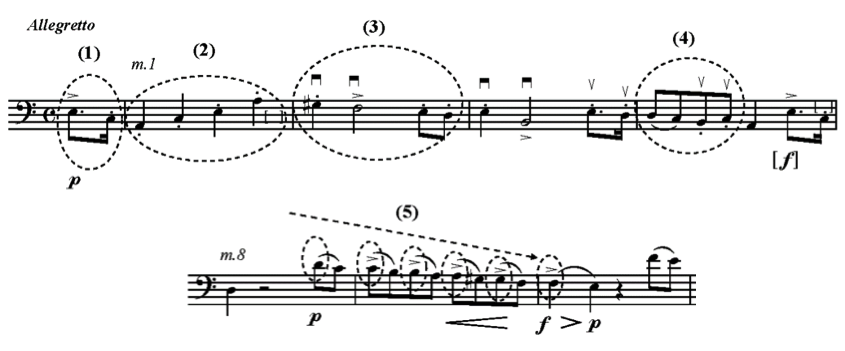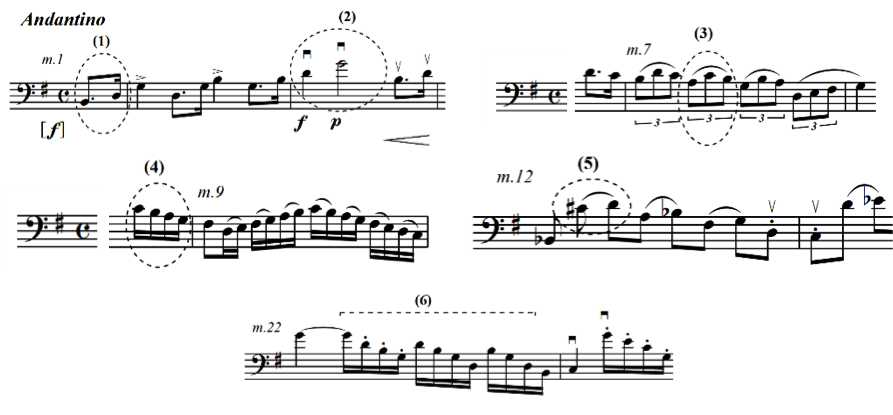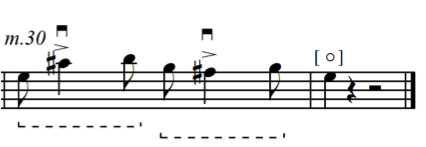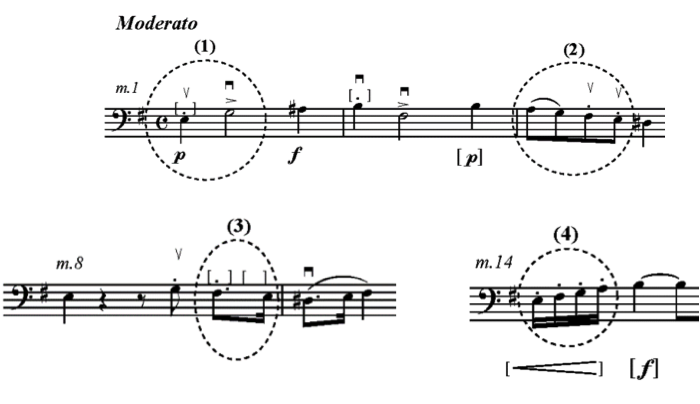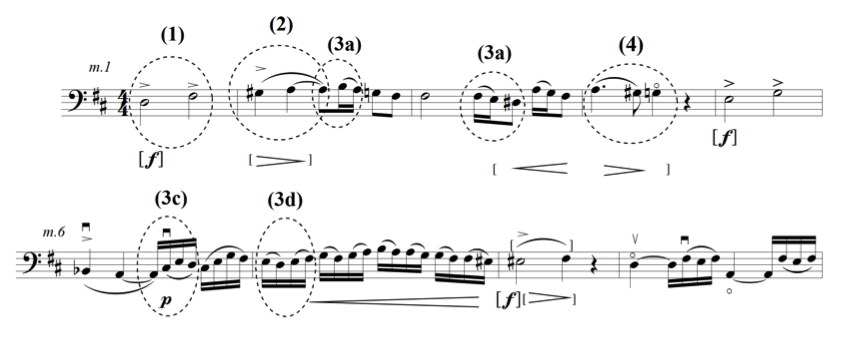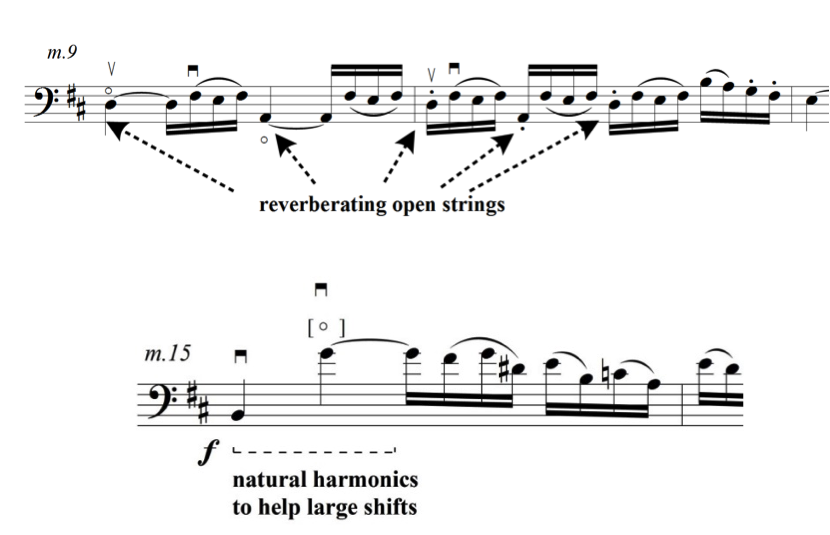| |
Volume 5, April 2015
Lino José Nunes's 1838 Methodo : Historical, Analytical and Editorial aspects of an Afro-Brazilian Double Bass Jewel
by Fausto Borém, Alfredo Ribeiro, Gustavo Neves, João Paulo Campos, and Rodrigo Olivarez
3. Part II of the Methodo: Lino José Nunes's six double bass Lessons
Part II of the "Methodo", called "Curso de Lições para o Contrabaxo" ("Course of Double Bass Lessons"; pp.10-15), was left incomplete in m.8 of the 7th lesson. However, this section brings the most musically interesting material of the "Method", namely the six complete lessons, which can be performed in recital programs as a set or separately. As J. S. Bach excelled in his Well-Tempered Clavier (1722), Nunes's plan was to pedagogically provide a set of 24 double bass lessons, covering all major and minor keys. His unifying scheme around the circle of fifths is evident in these six complete lessons, arranged in pairs of major-minor tonalities: C major-A minor, G major-E minor, D major-B minor. Other unifying factors among these lessons are the recurrence and development of thematic materials, such as military rhythms (reflecting the establishment of the new Brazilian Empire), syncopations, and opera elements (fermatas, recitatives, ornamented lines, the aria-cabaletta pair), as it will be shown. On the other hand, Nunes gives each lesson a unique personality, allowing the bassist to focus on specific technical elements.
Lesson 1, constructed as an A-B-A'-C form, acts as an introductory piece, constructed with easier and technically more restricted materials, namely the key of C major with no modulations (only a few altered neighboring tones), the limited range of a minor 10th (from A3 to C4), and mostly stepwise 8th notes with two-by-two slurs or staccato. But Nunes was also pedagogically concerned with the accompanying role of the orchestral double bass, especially in opera, a most favored genre in Imperial Rio. In the last note of m.15 he places a typical opera fermata, so the bassist can practice that neuralgic moment when he/she must pay more attention to the conductor, who pays attention to the soloist singer during his/her suspension of the metrics (usually happening in a fermata, cadenza or recitative) to finally resolve on the downbeat of the next measure (Ex.8). All notated symbols and words between brackets in the musical examples and in the performance editions reflect interferences to the original manuscript.
 Ex.8 — Fermata in Nunes´s Lesson 1: opportunity for the double bassist to practice a crucial element of the opera, a most favored genre in Imperial Brazil.
In Lesson 2, Nunes explores the contrast between military inspired music and the opera cantabile, very common genres in Imperial Rio in the first half of the 19th century. Although it does not modulate, Lesson 2 is musically much more challenging than Lesson 1. In the key of A minor, its rhapsodic A-B-C form is based on the thematic development of five motifs (Ex.9): (1) the martial pick up, (2) the marching staccato quarter notes, (3) the martial syncopation, (4) slurred and staccato 8th-note groups, and (5) the cantabile descending line of two-by-two slurred 8th notes in the fashion of the so-called Mannheim sighs (Sadie, 1988, p.462).
Ex.9 — The five thematic motifs in Nunes's Lesson 2.
Lesson 3 begins in G major, modulates to G minor in m.10 and returns to the home key in m.18. Not just this procedure, but also the use of secondary dominants and non-functional chromaticism gives the bassist the opportunity to focus on intonation correction of altered notes such as B flat, E flat, F natural, C sharp and A sharp. Heavily based on the classical patterns of double period phrasing (m.1, 8, 12, 18, 22), melodic repetitions and sequences, the rhapsodic nature of Lesson 3 (an A-B-C-D-F-G structure) seems to be derived from the theme and variations form, departing from six motifs (Ex.10): (1) the martial pickup, (2) the martial syncopation, (3) sequenced triplets (4) 16th-note groups, (5) syncopated slurred 8ths, and (6) virtuosic 16th-note arpeggios, reflecting Nunes's pedagogical preoccupation to teach skills in demand for the symphonic and operatic repertory.
Ex.10 — The six thematic motifs in Nunes's Lesson 3.
At the end of Lesson 3 (m.30), possibly pointing to his African descent, Nunes uses another kind of syncopation, namely the emerging so-called Brazilian syncopation (Ex.11). Typically in faster rhythms and sequenced, the Brazilian syncopation began to appear in nineteenth-century popular genres such as the lundu and modinha (Lima, 2010, Lima 2005) and become a standard feature in the twentieth-century genres of choro, samba, and bossa nova.
Ex.11 — The so-called Brazilian syncopation, used by Nunes at the end of Lesson 3.
An Italian opera expert (Andrade, 1967, vol.1, pp.113-126; vol.2, pp.121-130), Nunes favors that dramatic genre in Lesson 4. The two pairs of contrasting tempi (Moderato-Allegro in mm.1-23 and 1° Tempo-Allegro in mm.24-33), makes an A-B-A'-B' form and were clearly inspired by the aria-caballeta sequence. Here, they are like two miniatures of this typical Rossinian operatic pair (Taruskin, 2010b, p.1 of 9), which were very familiar to Nunes. Almost all materials in Lesson 4 are derived from four motifs (Ex.12) that had already appeared in previous lessons: (1) the large syncopation in m.1, (2) the four 8th-note group with two slurred notes followed by two staccato ones in m.2, (3) the martial dotted 8th note followed by a 16th note in m.8, and (4) scalar groups of 16th notes in m.14.
Ex.12 — The four basic motifs of Lesson 4.
Although Lesson 4stays in the key of E minor all the time, Nunes provides variety by giving bassists another opera treat. In section A', he creates a recitative with a polyphonic melody implying two "personas": (1) a cantabile upper stationary voice gravitating around the note E4 over (2) dramatic interventions of an ascending chromatic lower voice progressing from a G# 3 to a B3. The conduction of these independent and opposing melodic layers are emphasized by means of 8th-note rests strategically placed between them (Ex.13).
Ex.13 — Opera recitative in Lesson 4 with two independent contrasting "personas" (upper and lower voices).
Lesson 5 is structured according to an A-B-C-D-E rhapsodic form based on recurrences and development of four basic motifs presented right at the beginning of the piece. These motifs are common to previous lessons (Ex.14): (1) the marching martial half notes with marcato in m.1, (2) the syncopation in m.2, (3) slurred 16th-note groups and their variations in mm.2, 3 and 7, and (4) descending cantabile chromaticism in m.4.
Ex.14 — The four basic motifs of Lesson 5.
Harmonically speaking, Lesson 5 is the most challenging of the set and, therefore, the one presenting more intonation difficulties. Here, Nunes resorts to a sophisticated chromaticism that probably reflects his familiarity with masterworks by Mozart (Requiem14 and Don Giovanni15) and Bellini (Norma16), whose music he played and sang. Another influence could be Domenico Scarlatti (E Major Sonata K.264)17, the Italian who became a paragon in Portugal, while Brazil was its colony. While in D major, in a short span of time, Nunes covers the chromatic total using altered notes resulting from secondary dominants (D# in m.3, B flat in m.6, C natural in m.14) or non-functional ornamental chromaticism (G# in m.2, E# in m.7). If, within a big picture, Nunes used the circle of fifths to plan his double bass lessons (in a sequence of major-minor key pairs), he refers to it again internally in Lesson 5. By chaining modulations by the interval of a descending major third in a few measures (a procedure to be found in Europe among only the most adventurous composers), he completes the full harmonic cycle in three steps, by turning the key tonic into the mediant of the next key. He first moves from D major to B flat major (m.22), then from B flat major to G flat major (m.25) and, finally from G flat major back to D major (m.28), as shown in Ex.15. It is not a surprise that a very similar procedure is to be found in one of Nunes's role models: Mozart's Don Giovanni.18 Among the opera composers Nunes premiered in Rio was Giuseppe Verdi,19 who was known to explore distant tonalities. Although Verdi's Otello was premiered only 1887 — 40 years after Nunes had already written Lesson 5 — the dark nature of the G flat passage (with six flats!) in the Brazilian music shares the dark atmosphere and cantabile legato of the famous bass section solo in in the Italian opera (preparing the scene in the fourth Act in which Otello kills Desdemona), which gradually moves into tonalities also full of flats such as E flat minor (with six flats!) and C flat major (with seven flats!).
 Ex.15 — Lesson 5: Modulations to distant keys by major thirds around the circle of fifths (B flat major-G flat major-D major) anticipates by 40 years the double bass section solo from Verdi's Otello.
Another aspect of double bass idiomatic writing in Lesson 5 is Nunes's extensive use of reverberating open strings (mm.1, 6, 9,14,16, 22,30, 31 and 32) and natural harmonics (mm.15, 31, in order to help large shifts), as shown in Ex.16. The key of D major on the double bass yields the tonic, dominant and subdominant as the D, A and G open strings, strategically explored by Nunes.
Ex.16 — The reverberation of open strings (m.9) and natural harmonics (m.15) in Lesson 5.
As it happened in the previous lesson, Nunes also structured Lesson 6 as an A-B-C-D-E rhapsodic form. He resorted to five motifs — two used in previous lessons — (1) as the martial dotted 8th note plus a 16th note, (2) 8th notes slurred two-by-two or in staccato — and new motifs — (3) the 32nd-note turn, (4) the 16th-note group ornamented with a grace note, and (5) triplets (Ex.17).
Ex.17 — The five basic motifs of Lesson 6.
In Lesson 6, Nunes wants the bassist to focus on the achievement of clear articulation in operatic ornaments, such as the turns in mm.6, 15, and 16 and a really demanding sequence of eight groups of 16th notes grouped four-by-four with a grace note in the beginning of each (see Ex.24 below). Nunes also wanted the bassist to practice typical opera tempo changes as in the Allegro Moderato of the beginning turns into a "dim. o tempo" ("diminishing the tempo") in m.9 and to a "mto. expressivo" ("molto espressivo") in m.13, then comes back to a "1° Tempo" ("Tempo primo") in m.19, and finally rushes with an "apertando" ("pressing") in m.21, another trait of the cabaletta spirit.
|
|


